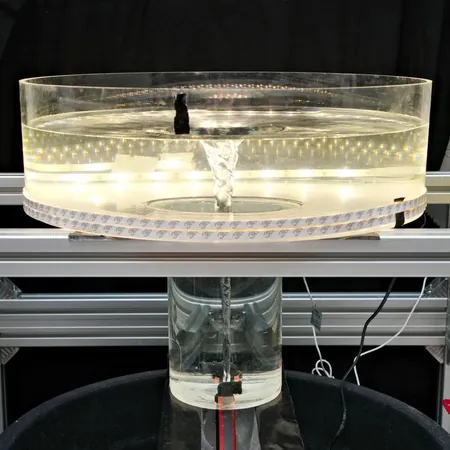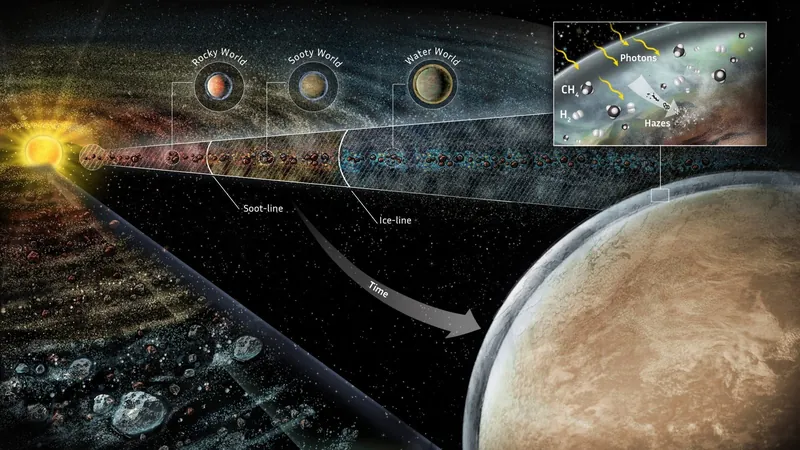
Revolutionizing Planet Formation: Exploring Water Tornadoes as Cosmic Models
2025-08-04
Author: Noah
From Classrooms to Cosmos: The Science of Water Tornadoes
Ever thought a classroom science experiment could unlock the secrets of the universe? Researchers from the Max Planck Institute for Astrophysics and the University of Greifswald have cracked this code by using a seemingly simple but ingenious model: spinning water! In a groundbreaking study published in the Monthly Notices of the Royal Astronomical Society Letters, they unveil how water tornadoes can simulate the formation of planets in vast protoplanetary discs.
Vortex Magic: Mimicking Cosmic Birth Processes
In a protoplanetary disc, swirling gases and dust engage in a gravitational dance around a newly formed star, gradually clumping into proto-planets. The researchers’ water vortex serves as an incredible representation of this process, showcasing how these tiny particles can eventually form the planets we know today. While simulations have been the norm for studying these cosmic mechanics, their computational complexities often leave scientists yearning for tangible data.
Engineering the Cosmos: A Clever Experiment
Creating a water vortex is a breeze with the right setup! This innovative system uses two transparent cylinders of varying sizes. Water is pumped into the smaller cylinder, creating a flow that spills into the larger one, where the fascinating whirlpool effect starts. Unlike previous models, which struggled with limited functionalities, this new design mirrors the dynamics of actual planet-forming discs more closely.
Tracking Cosmic Beads: A Dance of Physics
To validate their model, the team introduced beads into the vortex, capturing their movements with a high-speed camera. By analyzing the beads’ paths against the backdrop of Johannes Kepler's famed laws of planetary motion, they found that the beads followed the second and third laws fairly well, showcasing the potential of their model. However, they ran into challenges with the first law—beads were tracing spiral paths instead of the expected ellipses.
A Bright Future: Scaling Up for Success
The researchers have big plans ahead! They aim to enhance their system's size to foster more stable flows, which will naturally lead to elliptical paths, aligning more closely with Kepler’s first law. This next iteration could revolutionize our understanding of planetary formation, rekindling the childlike wonder of science along the way.
Conclusion: A Journey from the Lab to the Stars
As the team continues their experiments, they are not only exploring the universe but also rekindling the joy of simple science experiments. This transformative work may one day provide crucial insights into how the planets we inhabit came to be. Stay tuned for the next chapter in this cosmic tale!









 Brasil (PT)
Brasil (PT)
 Canada (EN)
Canada (EN)
 Chile (ES)
Chile (ES)
 Česko (CS)
Česko (CS)
 대한민국 (KO)
대한민국 (KO)
 España (ES)
España (ES)
 France (FR)
France (FR)
 Hong Kong (EN)
Hong Kong (EN)
 Italia (IT)
Italia (IT)
 日本 (JA)
日本 (JA)
 Magyarország (HU)
Magyarország (HU)
 Norge (NO)
Norge (NO)
 Polska (PL)
Polska (PL)
 Schweiz (DE)
Schweiz (DE)
 Singapore (EN)
Singapore (EN)
 Sverige (SV)
Sverige (SV)
 Suomi (FI)
Suomi (FI)
 Türkiye (TR)
Türkiye (TR)
 الإمارات العربية المتحدة (AR)
الإمارات العربية المتحدة (AR)